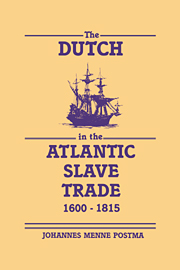Book contents
- Frontmatter
- Contents
- List of tables, figures, and maps
- Preface
- 1 Foundations of the slave traffic, 1600–61
- 2 Curaçao and the asiento trade, 1650–1730
- 3 The Dutch on the West African coast
- 4 Trade and politics on the African coast
- 5 Volume of African exports and origins of slaves
- 6 Organization and mechanics of the trade
- 7 The triangular trade
- 8 The Dutch plantation colonies under WIC monopoly, 1618–1738
- 9 The era of the free trade, 1730–80
- 10 The slaves: their treatment and mortality
- 11 Finances, marketing, and profitability
- 12 The end of the Dutch slave trade, 1781–1815
- Appendixes
- Bibliography
- Index
1 - Foundations of the slave traffic, 1600–61
Published online by Cambridge University Press: 16 September 2009
- Frontmatter
- Contents
- List of tables, figures, and maps
- Preface
- 1 Foundations of the slave traffic, 1600–61
- 2 Curaçao and the asiento trade, 1650–1730
- 3 The Dutch on the West African coast
- 4 Trade and politics on the African coast
- 5 Volume of African exports and origins of slaves
- 6 Organization and mechanics of the trade
- 7 The triangular trade
- 8 The Dutch plantation colonies under WIC monopoly, 1618–1738
- 9 The era of the free trade, 1730–80
- 10 The slaves: their treatment and mortality
- 11 Finances, marketing, and profitability
- 12 The end of the Dutch slave trade, 1781–1815
- Appendixes
- Bibliography
- Index
Summary
The slave trade from Africa to the Western Hemisphere was undoubtedly one of the major migrations in human history, a precursor to the even larger subsequent migration from Europe to the West. The migration from Africa was unique in that the emigrants were all forcibly transferred and, as slaves, were looked upon as social and racial inferiors by their European counterparts. As a consequence, the Atlantic slave trade made a significant and in many ways a lasting impact on the history of Africa and the Americas and to a lesser extent on Europe as well. Africa supplied the labor force, Europe the means of transportation and the necessary capital and commercial institutions, and the Americas the market for cheap labor for its plantations and mines. Thus, the slave trade provided a significant link between continents that surround the Atlantic. It contributed to the massive increase of world trade and the resulting accumulation of wealth, expanded the racial and cultural mosaic of Western societies, and became a major cause of racial conflicts in American societies. The slave trade itself produced one of the most embarrassing chapters in human history, which has haunted historians, moralists, and economists ever since.
For Africa, the Atlantic slave trade had major consequences, mostly negative. Although some scholars have suggested that its demographic impact was minimal and the economic results positive, others have stressed a wide range of negative consequences.
- Type
- Chapter
- Information
- The Dutch in the Atlantic Slave Trade, 1600–1815 , pp. 1 - 25Publisher: Cambridge University PressPrint publication year: 1990
- 1
- Cited by

